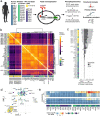This is a preprint.
The fitness cost of spurious phosphorylation
- PMID: 37873463
- PMCID: PMC10592693
- DOI: 10.1101/2023.10.08.561337
The fitness cost of spurious phosphorylation
Update in
-
The fitness cost of spurious phosphorylation.EMBO J. 2024 Oct;43(20):4720-4751. doi: 10.1038/s44318-024-00200-7. Epub 2024 Sep 10. EMBO J. 2024. PMID: 39256561 Free PMC article.
Abstract
The fidelity of signal transduction requires the binding of regulatory molecules to their cognate targets. However, the crowded cell interior risks off-target interactions between proteins that are functionally unrelated. How such off-target interactions impact fitness is not generally known, but quantifying this is required to understand the constraints faced by cell systems as they evolve. Here, we use the model organism S. cerevisiae to inducibly express tyrosine kinases. Because yeast lacks bona fide tyrosine kinases, most of the resulting tyrosine phosphorylation is spurious. This provides a suitable system to measure the impact of artificial protein interactions on fitness. We engineered 44 yeast strains each expressing a tyrosine kinase, and quantitatively analysed their phosphoproteomes. This analysis resulted in ~30,000 phosphosites mapping to ~3,500 proteins. Examination of the fitness costs in each strain revealed a strong correlation between the number of spurious pY sites and decreased growth. Moreover, the analysis of pY effects on protein structure and on protein function revealed over 1000 pY events that we predict to be deleterious. However, we also find that a large number of the spurious pY sites have a negligible effect on fitness, possibly because of their low stoichiometry. This result is consistent with our evolutionary analyses demonstrating a lack of phosphotyrosine counter-selection in species with bona fide tyrosine kinases. Taken together, our results suggest that, alongside the risk for toxicity, the cell can tolerate a large degree of non-functional crosstalk as interaction networks evolve.
Figures





Similar articles
-
The fitness cost of spurious phosphorylation.EMBO J. 2024 Oct;43(20):4720-4751. doi: 10.1038/s44318-024-00200-7. Epub 2024 Sep 10. EMBO J. 2024. PMID: 39256561 Free PMC article.
-
Deep Phosphotyrosine Proteomics by Optimization of Phosphotyrosine Enrichment and MS/MS Parameters.J Proteome Res. 2017 Feb 3;16(2):1077-1086. doi: 10.1021/acs.jproteome.6b00576. Epub 2016 Dec 5. J Proteome Res. 2017. PMID: 28152594
-
Phosphotyrosine-based Phosphoproteomics for Target Identification and Drug Response Prediction in AML Cell Lines.Mol Cell Proteomics. 2020 May;19(5):884-899. doi: 10.1074/mcp.RA119.001504. Epub 2020 Feb 26. Mol Cell Proteomics. 2020. PMID: 32102969 Free PMC article.
-
Evolution of SH2 domains and phosphotyrosine signalling networks.Philos Trans R Soc Lond B Biol Sci. 2012 Sep 19;367(1602):2556-73. doi: 10.1098/rstb.2012.0107. Philos Trans R Soc Lond B Biol Sci. 2012. PMID: 22889907 Free PMC article. Review.
-
Paxillin interactions.J Cell Sci. 2000 Dec;113 Pt 23:4139-40. doi: 10.1242/jcs.113.23.4139. J Cell Sci. 2000. PMID: 11069756 Review.
References
-
- Ahler E, Register AC, Chakraborty S, Fang L, Dieter EM, Sitko KA, Vidadala RSR, Trevillian BM, Golkowski M, Gelman H, et al. (2019) A Combined Approach Reveals a Regulatory Mechanism Coupling Src’s Kinase Activity, Localization, and Phosphotransferase-Independent Functions. Mol Cell 74: 393–408.e20 - PMC - PubMed
-
- Bachman JA, Sorger PK & Gyori BM (2022) Assembling a corpus of phosphoproteomic annotations using ProtMapper to normalize site information from databases and text mining. bioRxiv: 822668
Publication types
Grants and funding
LinkOut - more resources
Full Text Sources
